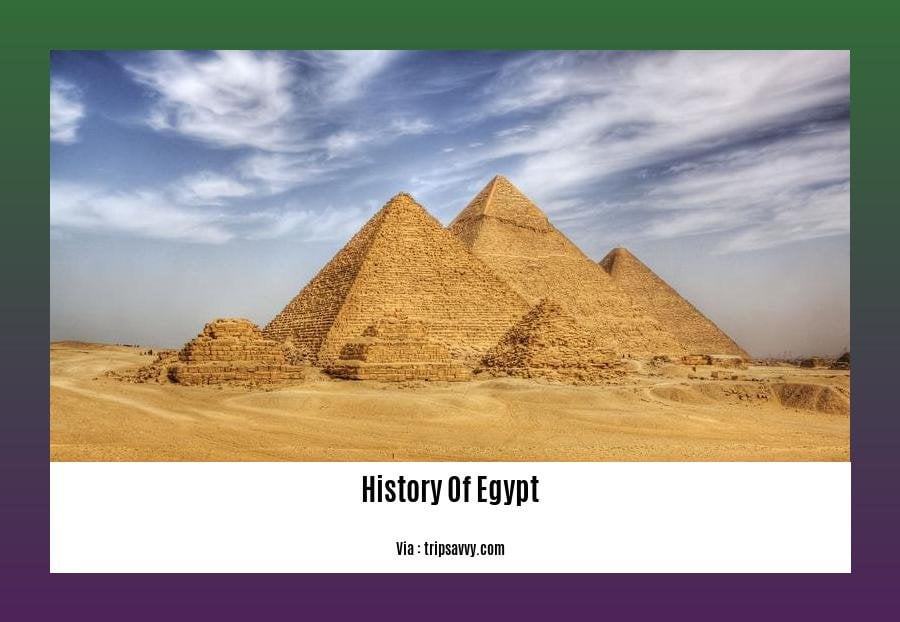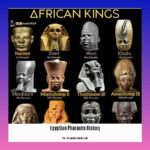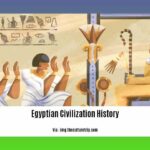Embark on an enlightening journey through the annals of time as we delve into [- Insights into the Comprehensive History of Egypt]. From the dawn of civilization in the fertile Nile Valley to the era of towering pyramids and enigmatic pharaohs, Egypt’s legacy spans millennia and continues to captivate the world.
Key Takeaways:
- Egypt has a rich history spanning over 7,000 years.
- Ancient Egypt was famous for its pyramids, temples, and hieroglyphs.
- Egypt has been invaded and occupied by various foreign powers throughout history.
- Egyptian culture has influenced and interacted with others, leaving a lasting impact on art, religion, and language.
- Modern Egypt is a diverse and evolving nation, navigating challenges and opportunities in various sectors.
History of Egypt
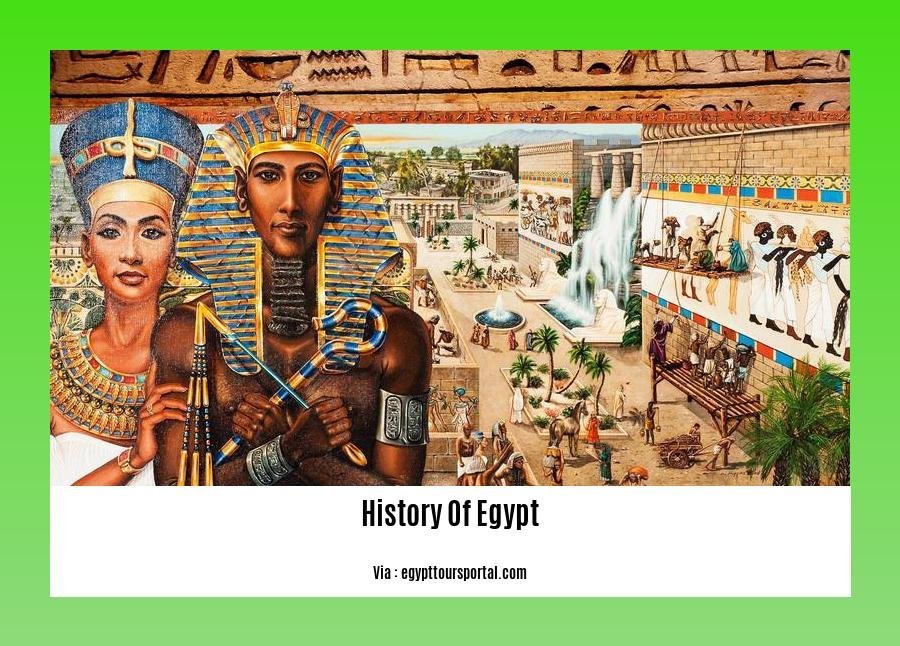
Egypt, a land steeped in ancient mysteries and enduring legacy, boasts a history stretching over 7,000 years. It’s a tapestry woven with tales of mighty pharaohs, iconic monuments, and cultural advancements that shaped the course of human civilization.
From its humble beginnings along the fertile Nile Valley, Egypt evolved into a powerful empire, leaving behind a wealth of architectural marvels that stand as testaments to the ingenuity of its people. The iconic pyramids of Giza and the sprawling temple complexes of Karnak and Luxor are just a few examples of their architectural prowess.
Timeline of Key Eras in Egypt’s History:
- Pre-Dynastic Period (c. 5,500 – 3,100 BCE): Emerged along the Nile River as small farming communities.
- Early Dynastic Period (c. 3,100 – 2,686 BCE): Upper and Lower Egypt united under a single ruler, forming the first unified kingdom.
- Old Kingdom (c. 2,686 – 2,181 BCE): Known for the construction of the Great Pyramids of Giza.
- First Intermediate Period (c. 2,181 – 2,055 BCE): A period of political instability and division.
- Middle Kingdom (c. 2,055 – 1,650 BCE): Restored stability and cultural prosperity.
- Second Intermediate Period (c. 1,650 – 1,550 BCE): Invaded by the Hyksos, an Asian people.
- New Kingdom (c. 1,550 – 1,070 BCE): Empire expanded to its greatest extent, ruled by famous pharaohs like Tutankhamun and Ramses II.
- Third Intermediate Period (c. 1,070 – 664 BCE): Divided into multiple kingdoms and faced invasions from the Libyans and Nubians.
- Late Period (c. 664 – 332 BCE): Ruled by the 26th Dynasty of Sais and faced conquests by the Persians.
- Ptolemaic Period (332 – 30 BCE): Conquered by Alexander the Great and ruled by his successors.
- Roman Period (30 BCE – 641 CE): Became a province of the Roman Empire.
- Byzantine Period (641 – 1250 CE): Ruled by the Byzantine Empire after the fall of Rome.
- Arab Conquest (641 CE): Conquered by the Arab army and introduced Islam.
- Ottoman Period (1517 – 1798 CE): Ruled by the Ottoman Empire.
- French Occupation (1798 – 1801 CE): Briefly occupied by the French army under Napoleon Bonaparte.
- Muhammad Ali Dynasty (1805 – 1952 CE): Modernization and reforms under the rule of Muhammad Ali Pasha.
- Republic of Egypt (1952 – Present): Declared a republic after the overthrow of the monarchy and faced various political and economic challenges.
Each era in Egypt’s history has left an indelible mark on its culture, art, and architecture. From the hieroglyphs that adorned temple walls to the intricate artifacts found in royal tombs, Egypt’s history continues to captivate and inspire.
Discover the fascinating story of Ancient Egyptian civilization that shaped the world. Uncover the profound significance of the Nile River in fostering life and culture. Explore Modern Egypt’s remarkable development as it embraces the future.
Historical Tapestry of Egypt Unveiled
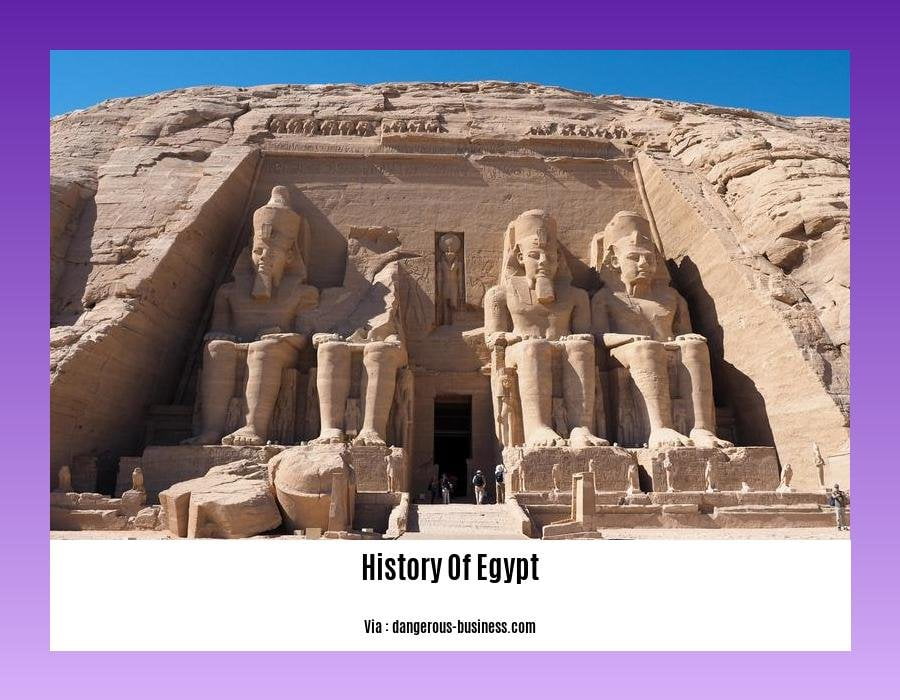
Egypt’s rich History is a symphony of civilizations that played a colossal role in shaping the course of Humanity. From its humble beginnings on the fertile banks of the Nile to its rise as a global power, Egypt’s story is one of grandeur, innovation, and resilience.
Key Takeaways:
- Habitats emerged along the Nile River in the 10th millennium BC.
- Hieroglyphics, the written language of ancient Egypt, was developed.
- King Hor-Aha unified Upper and Lower Egypt in 3100 BC.
- Hypnotic pyramids and majestuous temples stand as testaments to Egypt’s architectural prowess.
- Helenistic rule under the Ptolemaic dynasty influenced Egypt’s art, science, and literature.
Over the centuries, Egypt’s Historical landscape has been shaped by a diverse array of rulers, including pharaohs, Greeks, Romans, Arabs, and Ottomans. Each empire left its unique imprint on Egypt’s tapestry, contributing to its unparalleled cultural and intellectual legacy.
Scholars around the world continue to unravel the mysteries of ancient Egypt, deciphering Hieroglyphics, excavating Historical sites, and shedding light on the enduring impact this civilization has had on our world.
Sources:
* The Chronology and History of Egypt
* The History of Ancient Egypt
in the Footsteps of Egypt’s Past
Immerse yourself in the captivating history of Egypt, a cradle of civilization and a testament to human ingenuity. From the banks of the Nile to the colossal pyramids that stand tall, each chapter of Egypt’s story reveals the grandeur of its past.
Key Takeaways:
- The ancient Egyptians developed innovative writing systems like hieroglyphics, a key to unlocking their rich history.
- The Nile River, integral to their way of life, nurtured thriving settlements and sustained Egypt’s civilization.
- Influential rulers, such as Cleopatra and Alexander the Great, left lasting marks on Egypt’s political and cultural landscape.
- The influence of Egypt spread far beyond its borders, shaping art and architecture in neighboring regions.
- International collaboration among archaeologists and historians continues to reveal new insights into Egypt’s enigmatic past.
Sources:
Exploring the Comprehensive History of Egypt
Ancient Egypt: A Timeline of Human Civilization
Egypt’s captivating history unfolds like an epic tapestry, intricately woven with the threads of cultural, economic, and political advancements. Let’s delve into the timeline of this remarkable civilization:
Predynastic Egypt (pre-3150 BC):
– Nile River supported vibrant settlements from the 10th millennium BC.
– Tribal societies emerged, forming the foundations of centralized rule.
– Neolithic influences shaped daily life and agricultural practices.
Dynastic Egypt (3150–332 BC):
– King Menes unified Upper and Lower Egypt, establishing the first dynasty.
– Pyramids and temples rose as symbols of architectural ingenuity.
– The Middle Kingdom witnessed cultural and economic prosperity.
– The New Kingdom expanded Egypt’s empire, leaving legendary pharaohs like Tutankhamun in its wake.
– Egypt’s influence extended beyond its borders, influencing art, literature, and science globally.
Key Takeaways:
- Egypt’s history spans over 7,000 years, leaving an enduring legacy on humanity.
- The Nile River served as a lifeline, fostering the growth of civilizations along its banks.
- Ancient Egyptians developed a sophisticated writing system, hieroglyphics, to record their history.
- Egypt’s architectural marvels, such as the pyramids and temples, showcase the brilliance of its engineers and builders.
- Egypt’s legacy continues to inspire and captivate people worldwide.
Sources:
FAQ
Q1: What were the key features of Predynastic Egypt?
A1: Predynastic Egypt, before 3150 BC, witnessed the rise of agricultural communities along the Nile, the development of hieroglyphic script, and the emergence of centralized societies, laying the foundation for the later dynastic period.
Q2: What major achievements characterized Dynastic Egypt?
A2: Dynastic Egypt, spanning from 3150 to 332 BC, is renowned for its monumental achievements, including the construction of pyramids, the development of a complex system of government, and the flourishing of art, culture, and science under the rule of pharaohs like Tutankhamun.
Q3: How did the environment influence the development of ancient Egypt?
A3: The Nile River was the lifeblood of ancient Egypt, providing fertile lands for agriculture and facilitating trade. However, climate changes and the desiccation of pastoral lands in the Sahara also played a role in shaping the settlement patterns and social structures of the early Egyptians.
Q4: What were the major external influences on Egypt’s history?
A4: Throughout its long history, Egypt has experienced invasions and occupations by various foreign powers, including the Persians, Greeks, Romans, Arabs, Turks, and British. These interactions brought cultural exchanges and advancements, leaving a lasting impact on Egypt’s society and heritage.
Q5: How has Egypt’s history shaped its modern identity?
A5: Egypt’s rich and diverse history has shaped the country’s modern identity, reflected in its cultural traditions, artistic expressions, and political institutions. The legacy of ancient Egypt continues to inspire and influence contemporary Egyptian society, fostering a sense of national pride and cultural continuity.
- Sept 31 Myth: Unveiling Calendar Secrets - March 18, 2025
- How Long & Till December 18, 2025: Accurate Countdown Guide - March 18, 2025
- Discover Japanese Artists: A Complete History - March 18, 2025
